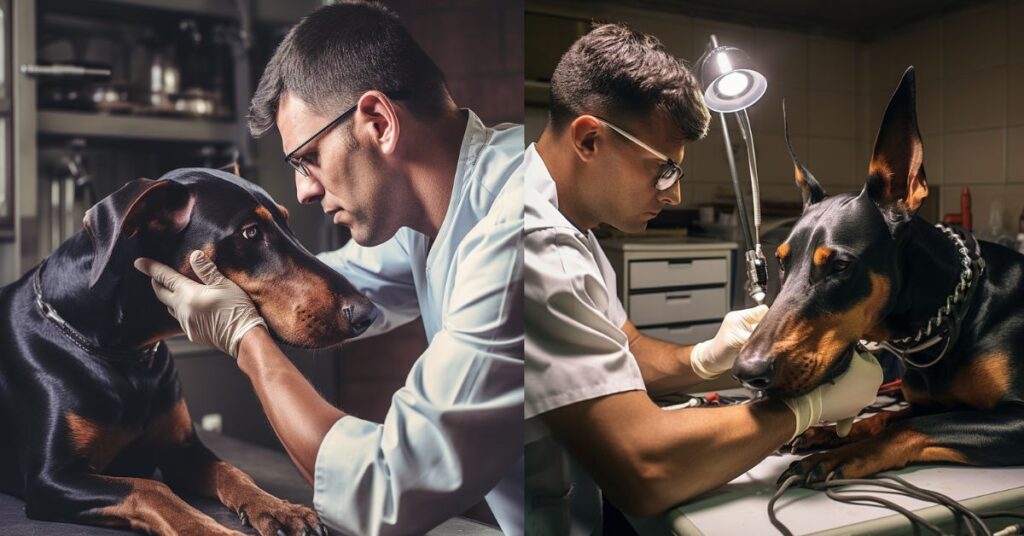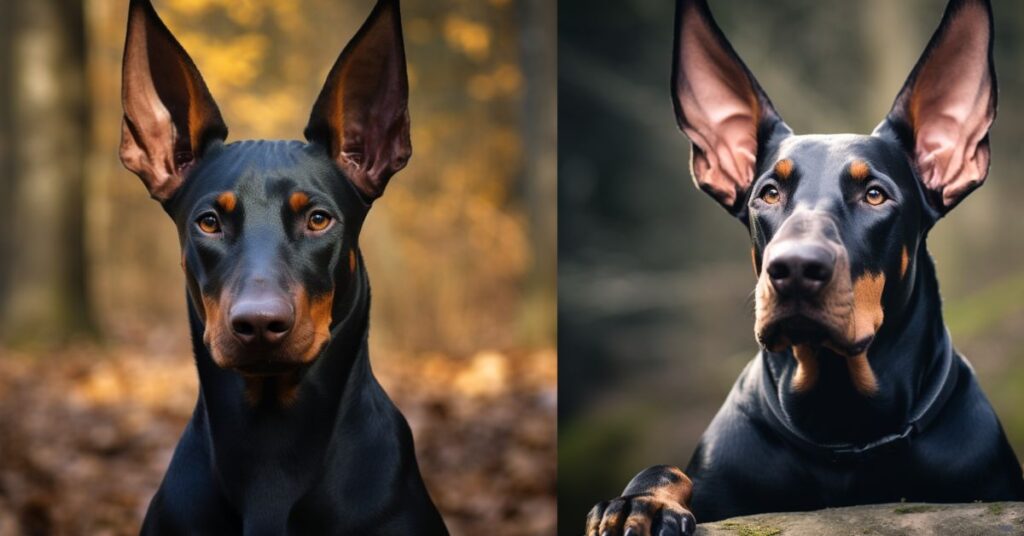Doberman ear cropping is a surgical procedure that involves altering the shape and appearance of a Doberman Pinscher’s ears. It is a practice that has been done for many years and is often associated with the breed’s iconic look. During the procedure, part of the ear is surgically removed, and the remaining tissue is shaped and sutured to create an upright and pointed ear.
Importance of understanding the timing for ear cropping
Understanding the timing for ear cropping is crucial for dog owners considering this procedure for their Doberman. The age at which ear cropping is done can significantly impact the outcome and healing process. It is important to be aware of the ideal age for ear cropping to ensure the best results.
Ear cropping is typically done during a specific window of time when the puppy’s ears are still malleable and can be shaped as desired. If the procedure is done too early or too late, it can lead to complications or undesirable outcomes. Therefore, it is crucial for dog owners to have a good understanding of when to schedule the ear cropping procedure.
By being informed about the timing for ear cropping, dog owners can make educated decisions and work closely with their veterinarians to ensure the best possible outcome for their Doberman’s ears.

Understanding Doberman Ears
Natural ear characteristics of Dobermans
Doberman Pinschers are known for their naturally floppy ears. When left unaltered, their ears hang down, framing their face in a soft and gentle manner. The natural ear shape of a Doberman is a result of genetics and breed characteristics.
It’s important to note that not all Dobermans have the same ear shape or size. Some may have larger ears that droop more, while others may have smaller ears that stand up slightly. Each dog is unique, and their ear appearance can vary within the breed.
The purpose and history of ear cropping in Dobermans
The practice of ear cropping in Doberman Pinschers has a historical background. In the past, it was believed that ear cropping had practical purposes such as enhancing the dog’s hearing capabilities and reducing the risk of ear infections. Additionally, it was thought that cropped ears gave the Doberman a more alert and intimidating look, which was desirable for their roles as guard dogs and working dogs.
Over time, the perception of ear cropping has evolved, and its primary purpose has shifted towards aesthetics and adhering to breed standards. The American Kennel Club (AKC) and other breed organizations have established specific standards for Dobermans, including the requirement for cropped ears in conformation shows.
It’s important to recognize that ear cropping is a personal choice and not mandatory. Many Doberman owners choose not to crop their dog’s ears and appreciate the natural beauty of floppy ears. However, for those who decide to crop, it’s essential to consider the historical context and understand that the practice originated from functional reasons that have now transitioned into mainly cosmetic ones.
Understanding the natural ear characteristics of Dobermans and the historical significance of ear cropping can help dog owners make informed decisions about the appearance of their Doberman’s ears while considering the breed’s heritage and individual preferences.

The Ideal Age for Ear Cropping
Veterinarian recommendations
When it comes to determining the ideal age for ear cropping in Doberman Pinschers, it is essential to consult with a qualified veterinarian. Veterinarians who have experience with the breed can provide valuable insights and guidance on the timing of the procedure.
Veterinarians often recommend that ear cropping be performed between 8 to 12 weeks of age. During this period, the puppy’s ears are still soft and pliable, making it easier to shape them into the desired form. The exact timing may vary depending on individual factors, so it’s crucial to work closely with a knowledgeable veterinarian to determine the best age for your Doberman.
Factors to consider when deciding on the age
Health considerations
The health and well-being of the puppy should always be the top priority. Before considering ear cropping, it is essential to ensure that the puppy is in good overall health. Puppies should undergo a thorough veterinary examination to assess their physical condition and confirm that they are suitable candidates for the procedure.
Breed standards and show requirements
If you plan to show your Doberman in conformation competitions, it’s important to familiarize yourself with the breed standards set by organizations such as the American Kennel Club (AKC). These standards often require cropped ears for show dogs. If participating in shows is a priority for you, it may influence your decision on the timing of ear cropping to meet the breed standards.
Personal preferences and lifestyle
Personal preferences play a significant role in the decision-making process. Some owners prefer the aesthetic appearance of cropped ears, while others appreciate the natural look of floppy ears. It’s important to consider your personal preferences and how they align with the breed’s heritage and your lifestyle. Additionally, take into account the commitment required for proper aftercare and maintenance of cropped ears.
Ultimately, the ideal age for ear cropping should be determined by a combination of veterinary recommendations, health considerations, breed standards, personal preferences, and lifestyle factors. By carefully evaluating these factors and seeking professional advice, you can make an informed decision that is best suited for your Doberman.

Benefits and Risks of Ear Cropping
Benefits of ear cropping
Aesthetic appeal and breed recognition
One of the primary reasons why some Doberman owners choose to crop their dog’s ears is for the aesthetic appeal it provides. Cropped ears can give Dobermans a more alert and regal appearance, emphasizing their strong and confident demeanor. Many individuals appreciate the iconic look that cropped ears bring to the breed.
Additionally, cropped ears are often associated with breed recognition. In conformation shows and competitions, where adherence to breed standards is important, cropped ears may be required for Dobermans to compete and be recognized as representatives of the breed.
Potential reduction in ear infections
It is believed by some that ear cropping can potentially reduce the risk of ear infections in Dobermans. The theory behind this is that cropped ears allow for increased airflow to the ear canal, reducing moisture buildup and the chances of bacterial or fungal infections. However, it’s important to note that this claim is not universally agreed upon, and the correlation between ear cropping and reduced ear infections is still a topic of debate.
Risks and complications associated with ear cropping
Surgical risks and recovery process
Ear cropping is a surgical procedure that carries inherent risks and potential complications. It involves anesthesia, incisions, tissue removal, and suturing. As with any surgery, there is always a risk of bleeding, infection, adverse reactions to anesthesia, poor wound healing, and other surgical complications. Additionally, the recovery process can be uncomfortable for the dog and may require careful monitoring and post-operative care.
It’s crucial to choose a skilled and experienced veterinarian who adheres to proper surgical techniques and practices to minimize these risks. A thorough discussion with your veterinarian about the surgical risks, aftercare procedures, and expected recovery timeline can help you make an informed decision.
Potential impact on hearing and communication
Another consideration when it comes to ear cropping is the potential impact on a Doberman’s hearing and communication abilities. The ears play a crucial role in capturing and funneling sound waves into the ear canal. Some individuals raise concerns that cropped ears may impact a dog’s ability to hear and communicate effectively. While there is no definitive evidence supporting this claim, it is important to acknowledge the possibility and discuss it with your veterinarian.
As a responsible dog owner, it’s essential to carefully weigh the benefits and risks associated with ear cropping. Consulting with a knowledgeable veterinarian, considering the individual dog’s health and temperament, and understanding the potential complications can help you make an informed decision that aligns with your Doberman’s well-being and your personal preferences.
Responsible Decision-Making
Researching reputable veterinarians and professionals
When considering ear cropping for your Doberman, it’s crucial to do thorough research and find a reputable veterinarian who specializes in the procedure. Look for veterinarians who have experience working with Dobermans and a proven track record of performing successful ear crops.
Take the time to read reviews and testimonials from other pet owners who have had their Dobermans’ ears cropped. This can give you insight into the veterinarian’s expertise, professionalism, and the overall satisfaction of their clients. It’s important to choose a veterinarian who prioritizes the health and well-being of the dog and follows proper surgical techniques and aftercare protocols.
Consulting with experienced Doberman breeders and owners
Another valuable resource when making a decision about ear cropping is consulting with experienced Doberman breeders and owners. They can provide first-hand knowledge and experiences regarding ear cropping and its impact on the breed.
Reach out to reputable breeders or join online communities and forums dedicated to Dobermans. Engage in discussions and ask questions about ear cropping. Learn from the experiences of others and gather different perspectives to help you make an informed decision. However, always remember that individual opinions may vary, so consider multiple viewpoints when forming your own conclusions.
Evaluating personal commitment to aftercare and maintenance
Proper aftercare and maintenance are essential aspects of ear cropping. After the surgery, the dog’s ears will require regular cleaning, bandaging, and monitoring to ensure proper healing. It’s important to evaluate your own commitment and ability to provide the necessary care and attention during the recovery period.
Consider factors such as your availability, willingness to adhere to aftercare instructions, and the resources required for ongoing maintenance. Cropped ears may require taping or posting to encourage proper shaping as they heal. This process can be time-consuming and may need to be continued for several months.
If you’re uncertain about your ability to commit to the aftercare and maintenance requirements, it may be best to opt for natural ears or wait until you are confident in your ability to meet these responsibilities.
By conducting thorough research, consulting with experienced individuals, and evaluating your own commitment level, you can make a responsible decision about whether ear cropping is suitable for your Doberman. Remember, it’s essential to prioritize the health and well-being of your dog and ensure that your decision aligns with their best interests.
Legal Restrictions and Regulations
Regional variations and legislation regarding ear cropping
It’s important to note that the legality of ear cropping can vary depending on your location. Different countries, states, and regions may have specific laws and regulations in place regarding the practice. It is crucial to understand and abide by these rules to ensure you are in compliance with the law.
For example, in some countries, ear cropping is considered a form of animal cruelty and is illegal. In other regions, it may be allowed but strictly regulated. Additionally, the age at which ear cropping is permitted may also vary, with some jurisdictions specifying a minimum age requirement.
To ensure you are well-informed, research the specific laws and regulations in your area. Consult with local veterinary professionals or animal welfare organizations to get accurate and up-to-date information on the legal status of ear cropping in your region.
Understanding breed-specific regulations and restrictions
In addition to regional laws, certain breed-specific regulations and restrictions may impact your decision regarding ear cropping. Organizations such as kennel clubs and breed associations often establish breed standards that outline desired physical characteristics, including ear shape and appearance.
If you plan to show your Doberman in conformation competitions, it’s important to understand and adhere to the breed standards set forth by reputable organizations like the American Kennel Club (AKC). These standards may specify the preferred ear shape, whether cropped or natural.
Furthermore, some kennel clubs or breed associations may have specific rules regarding ear cropping for registration purposes. It’s important to research and understand these guidelines to ensure you meet the necessary requirements if you intend to register your Doberman.
Always prioritize the well-being and ethical treatment of your dog. If ear cropping is illegal or restricted in your region, or if you have concerns about the procedure’s impact on your dog’s health and well-being, it may be best to consider alternate options.
Note: It is crucial to consult with local authorities, veterinary professionals, and breed-specific organizations to understand the legal restrictions and regulations regarding ear cropping in your specific region. The information provided here is general and may not reflect the current laws and regulations in your area.
Alternatives to Ear Cropping
Natural ear care and maintenance
If you are uncertain about or uncomfortable with the idea of ear cropping for your Doberman, there are alternative options that allow for natural ear appearance while still ensuring proper care and maintenance.
- Regular cleaning: Proper ear hygiene is essential for all dogs, regardless of whether their ears are cropped or not. Regularly inspect your Doberman’s ears for any signs of infection, such as redness, swelling, or discharge. Clean the ears gently using a veterinarian-recommended ear cleaning solution and cotton balls or pads. Be cautious not to insert anything deep into the ear canal to avoid causing damage. Consult with your veterinarian for specific instructions on ear cleaning techniques and frequency.
- Hair removal: Some Dobermans may have excessive hair growth inside their ears, which can lead to increased moisture and potential ear infections. Plucking or trimming the hair inside the ear can help maintain better airflow and reduce the risk of infection. However, it’s crucial to consult with a professional groomer or your veterinarian for appropriate hair removal techniques to avoid causing discomfort or injury to your dog.
- Preventative measures: To minimize the risk of ear infections, take proactive steps such as keeping your Doberman’s ears dry after bathing or swimming. Avoid prolonged exposure to water and ensure that the ear canal is thoroughly dried. Additionally, avoiding allergens and irritants that can trigger ear issues, such as certain cleaning products or environmental factors, can also help maintain ear health.
Cosmetic options for uncropped ears
If you prefer the appearance of cropped ears but decide against the surgical procedure, there are cosmetic options available to give the illusion of a cropped look.
- Ear bracing and taping: Ear bracing and taping techniques involve using specialized devices or materials to shape the natural ears into an upright position. This method requires careful application and ongoing maintenance, as well as regular monitoring to ensure the dog’s comfort and well-being. Consult with a professional who specializes in ear bracing for guidance on the proper technique and duration of use.
- Ear prosthetics: Some companies offer customized ear prosthetics that can be attached to a dog’s natural ears to create the appearance of cropped ears. These prosthetics are typically made of lightweight, comfortable materials and are designed to mimic the shape and size of cropped ears. If you are considering this option, it’s important to research reputable providers and consult with your veterinarian for recommendations.
Remember, while alternative options can provide visual appeal, they do not guarantee the same breed recognition or adherence to specific show standards as cropped ears. Ultimately, the decision to pursue alternative methods should prioritize the well-being and comfort of your Doberman.
Conclusion
Recap of key points discussed
In this blog post, we have explored the topic of ear cropping for Dobermans with a focus on responsible decision-making. Let’s recap the key points discussed:
- Researching reputable veterinarians and professionals: Take the time to find a veterinarian who specializes in ear cropping and has a proven track record of successful procedures. Read reviews and gather input from other pet owners to make an informed choice.
- Consulting with experienced Doberman breeders and owners: Seek advice and guidance from experienced individuals who have firsthand knowledge of ear cropping and its impact on the breed. Engage in discussions and consider multiple perspectives to gain a better understanding.
- Evaluating personal commitment to aftercare and maintenance: Consider the time and resources required for proper aftercare and ongoing maintenance. Be honest about your ability to provide the necessary care and attention during the recovery period.
- Understanding regional variations and legislation regarding ear cropping: Familiarize yourself with the laws and regulations specific to your location. Ensure that you are in compliance with the legal requirements surrounding ear cropping.
- Recognizing breed-specific regulations and restrictions: Some kennel clubs and breed associations have specific guidelines for ear cropping as part of breed standards. If you plan to show your Doberman, it’s important to understand and adhere to these standards.
- Exploring alternatives to ear cropping: Natural ear care and maintenance techniques, such as regular cleaning and hair removal, can help maintain healthy ears. Additionally, cosmetic options, like ear bracing and taping or prosthetics, can create the appearance of cropped ears without surgery.
Encouragement to make an informed decision based on individual circumstances and preferences
Ultimately, the decision to have your Doberman’s ears cropped or not is a personal one. It should be made based on careful consideration of all the factors discussed in this blog post, including your region’s laws, breed standards, and your ability to provide the necessary care.
It’s important to remember that responsible decision-making means prioritizing the health and well-being of your dog above all else. Take the time to gather information, consult with professionals and experienced individuals, and reflect on your own circumstances and preferences.
By making an informed decision, you can ensure that you are acting in the best interest of your Doberman and providing them with a loving and responsible home.
